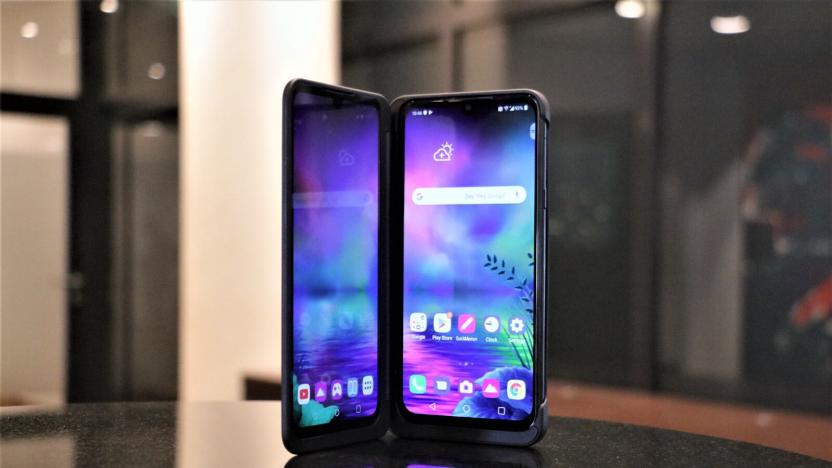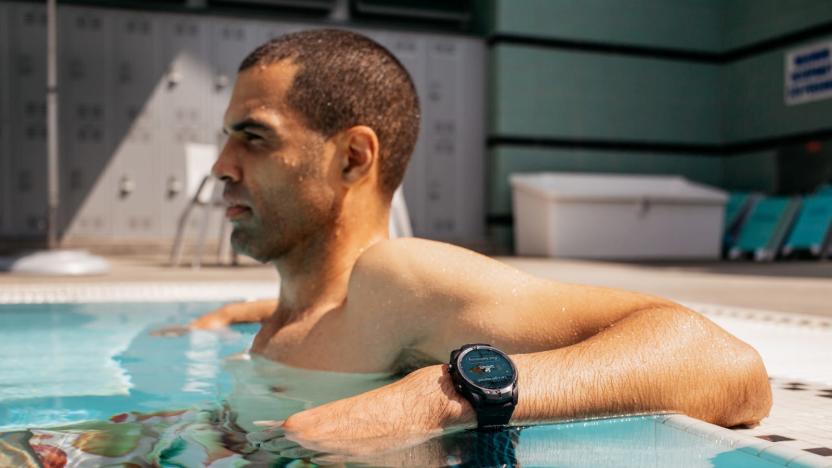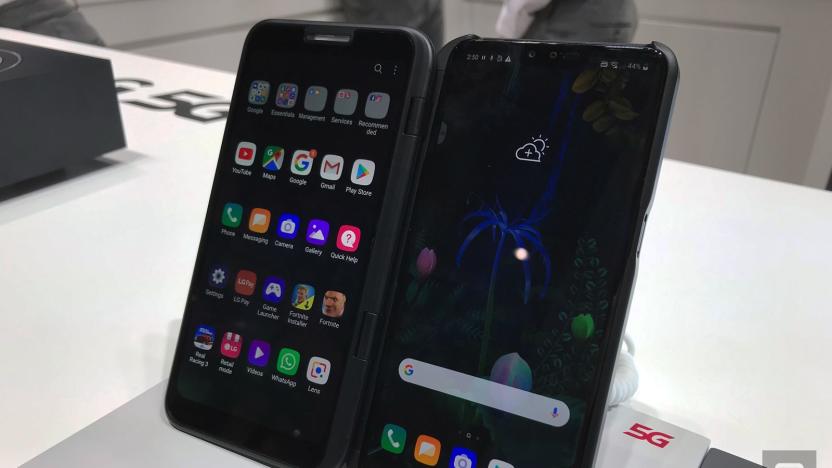dual screen
Latest

Microsoft updates developers on designing apps for dual-screens
As 2020 draws closer, we're also slowly nearing the debut of dual-screen devices from Microsoft and others. Now that the Surface Duo and Surface Neo have been revealed, the company's next step is to help developers get their software ready for the new devices. While deeper details will have to wait until early next year, the message sent to developers via a blog post is that current apps (on Android and Windows 10X) will work without needing new tools and redesigns. As far as making apps that can take advantage of new capabilities presented by these convertible devices, the idea is for a "common model" that overlays either Windows or Android. We'll have to wait and see what that looks like in practice, but with both the Duo and Neo scheduled to arrive in the holiday season next year, hopefully developers have enough time to figure out what works -- and what doesn't -- before they go on sale.
Richard Lawler11.26.2019
LG G8X ThinQ review: More screens aren't always better
As far as smartphone makers go, LG is an oddball. It takes a certain degree of chutzpah to design, build and market devices that completely defy convention. And this company has been responsible for more than a few of those over the years. The modular G5 springs to mind. So does this year's G8 ThinQ, which offered a gesture-based control scheme that seemed silly until it didn't. And now there's the G8X, which ditches some of the gimmicks that made the original G8 so divisive and embraces a few of its own. See, rather than build a proper foldable that would be inherently compromised, LG decided there was a better way to make smartphones more flexible: cases with secondary screens built into them. The V50 ThinQ was the company's first phone to get one of these cases, but now the G8X is going on sale around the world with one of these nutso accessories in tow. I have a deep, abiding respect for companies willing to embrace weirdness, but I'll be clear up front: LG's vision doesn't work. It's not because the underlying idea is bad; it's because LG hasn't figured out how to use this bizarre, dual-screen setup to its fullest.
Chris Velazco10.30.2019
AT&T offers the LG G8X with a 'free' Dual Screen case (updated)
If you want a US-ready folding phone but feel the Galaxy Fold is well beyond your price range, you now have an alternative -- if you don't mind two main displays instead of one, that is. AT&T has announced that it's carrying the LG G8X ThinQ starting on November 1st, with pre-orders starting just after midnight on October 25th. It'll normally cost $780, although you can snag it for $10 per month on a 30-month plan if you're adding a new line. And if you do add a new line, you'll get the virtually mandatory Dual Screen add-on for free.
Jon Fingas10.22.2019
Microsoft's Surface Neo will use Intel's next-gen Lakefield CPU
The flashiest PC that Microsoft unveiled at its event today has got to be the dual-screen Surface Neo, powered by the new Windows 10 X OS. It turns out that device will be the first one we've heard of to get Intel's next-generation Lakefield processor with a 10-nanometer primary Sunny Cove core, four 10-nanometer "Tremont" cores and Foveros 3D chip stacking technology.
Steve Dent10.02.2019
Microsoft embraces dual-screen computing with the Surface Neo
Microsoft has been mulling over the value of a dual-screen computer for at least a decade, and now it finally built one. Microsoft hardware chief Panos Panay pulled back the curtain on the new Surface Neo at a press conference in New York, and it essentially looks like -- what else? -- a foldable Surface.
Chris Velazco10.02.2019
LG's next dual-screen phone may gain a small outer display (updated)
While Samsung and Huawei refine their foldable devices, LG has introduced expanding hardware with its V50 ThinQ (shown above) that uses a case to add a second screen. The company's invite to its unveiling event on September 6th at IFA 2019 in Germany suggests it will continue to develop that strategy, with a video done up in 8-bit style that expands from one narrow screen across a second one. What's new, though, is a small screen on the outer side for showing the time and date.
Richard Lawler08.06.2019
The latest TicWatch Pro includes 4G LTE to free you from your phone
Mobvoi's second generation TicWatch Pro is available today, and the company hopes it will free you from your phone. The Wear OS-powered TicWatch Pro 4G/LTE offers wireless connectivity, so you can receive voice calls and app notifications, send and receive texts and use popular messaging apps. You can also hit an SOS button that will dial 911, and it will automatically sync your data with the cloud -- all without tethering you to another device.
Christine Fisher07.10.2019
Microsoft's dual-screen tablet could run Android apps
Microsoft could release a radically different Surface as early as the first half of 2020. Rumors about a dual-screen tablet have been circulating since last year, and the company reportedly showed a similar device to employees earlier this month. Now, market research firm IHS Markit told Forbes that the device will be ready sometime in the first six months of 2020, and it's expected to run both Android apps and Apple's iCloud.
Christine Fisher06.24.2019
Intel's 2-in-1 prototype proves it has big plans for dual-screen PCs
Intel surprised us last Computex with unique dual-screen prototypes like its Tiger Rapids device with an e-ink screen. This year, the company had even more concepts to show off at its technology open house. It showcased laptops from its Project Athena program and an intriguing Honeycomb Glacier idea that envisions different ways to make powerful laptops with integrated companion screens. Intel also gave us a glimpse at its new dual-screen prototype called Twin Rivers, demonstrating how its eighth-generation (and newer) processors are able to power such a resource-demanding device. As I played around with this prototype and Intel's other experiments, one thing became clear: The future of PCs is incredibly exciting.
Cherlynn Low05.29.2019
The LG V50's Dual Screen is a half-step towards a foldable phone
Despite foldable phones being all the rage at MWC, one of the bigger companies at the show didn't have one. LG has been clear that it won't introduce a foldable phone anytime soon, choosing instead to focus on its 5G flagship, the V50 ThinQ. And it's for good reason. As the company's head of mobile Brian Kwon told The Korea Times earlier this month, LG's more pressing concern "is to regain its market position. Considering this situation, it is too early for LG to launch a foldable smartphone." So instead of trotting out a foldable model for the hordes in Barcelona to swoon over, it showed off a second-display case for the V50 ThinQ. Or as LG calls it, the Dual Screen.
Billy Steele02.27.2019
LG's V20 will be the first Android Nougat smartphone
LG will launch the V20 smartphone in September, and it will be the first to get Android 7.0 Nougat. It's the successor to LG's wacky V10 phone, and will have the same dual-screen, dual-selfie camera features (no other specs were revealed). The news means that the V20 will likely be released before any Nexus phones, which are usually the first with the latest Android operating systems. That would be an unusual move by Google, but LG has confirmed the news with Engadget.
Steve Dent08.01.2016
YotaPhone 2's US launch canceled after crowdfunding success
We sort of loved the dual-screened YotaPhone 2, and we weren't alone -- nearly 450 people ordered devices from the company's Indiegogo campaign earlier this month, and a few of them are going to be very disappointed. In an email (obtained by The Verge) fired off to backers earlier this morning, Yota Devices cancelled the phone's US launch entirely thanks to "unforeseen delays including both production and delivery of the North American variant of YotaPhone 2 from our manufacturer."
Chris Velazco07.31.2015
Dual-screen YotaPhone 2 arrives in Europe this month
Yota was slightly cruel to YotaPhone fans. It unveiled the next generation of its dual-display smartphone way back in February... and left people wondering about the launch window for most of the year. At last, though, you can try this two-screened device for yourself. The YotaPhone 2 is now slated to launch in Europe this month for 32,990 rubles in the company's native Russia, or about $612. The hardware hasn't changed much since the start of 2014, which makes this a mid-range device with a few tricks up its sleeve. You're still looking at a 5-inch 1080p AMOLED display at the front, and that signature 4.7-inch e-paper touchscreen at the back for basic tasks and alerts; inside, there's a respectable Snapdragon 800 processor, 32GB of storage, an 8-megapixel rear camera and a 2-megapixel front shooter.
Jon Fingas12.02.2014
Sci-fi RTS Salvaged takes two screens to play on PC, tablet
Opposable Games recently showed off Salvaged, a real-time strategy game that requires a bit of multitasking from its players. The tactical sci-fi game is played using two screens, one on any iOS or Android tablet or smartphone (as the controller) and the other being a monitor via PC, Mac or Linux. In Salvaged, players act as one of many operators for a Remote Interstellar Salvage Crew (RISC), boarding wrecked ships to locate loot and retrieve each ship's black box recorders. The touchscreen in players' hands offers a top-down view of the frantic, squad-based action, allowing players to issue commands to their team and assess alien threats as well as interact with the wrecked ships themselves by hacking terminals, downloading data and restoring power and lighting. The second screen on players' PCs shows the operation in real-time through the squad's shoulder-mounted cameras. The UK developer cited classic games like Captive and the 1993 version of Space Hulk as well both the original XCOM and XCOM: Enemy Unkown as inspirations for the game, though players may recall FTL: Faster Than Light and Spelunky when it comes to the game's replayability. Salvaged's crew, environments, enemies and spoils are all procedurally generated, and like the aforementioned roguelikes, once a crewmember dies, they will be gone forever. The developer is seeking $125,000 by Thursday, May 15 to fund the game, of which it is just scratching the $10,000 mark as of this writing. [Image: Opposable Games]
Mike Suszek04.18.2014
Dual-screen YotaPhone has a second shot at greatness
If you caught our review of the YotaPhone at the end of last year, you'll know we were cautious about recommending it -- in fact, we said it was probably safer to hold out for a second-gen device. Well, here's a surprise: that replacement is already at the prototype stage and it brings some big improvements that could undo many of the criticisms we leveled at the original. Most importantly, the rear E-Ink panel is now fully touch sensitive, which means you'll be able to do a lot more with this phone without ever needing to engage the traditional, power-hungry display on the other side. Calls, texts, emails, browsing, tweeting and more can be handled using the "always-on" 4.7-inch E-Ink display, with the only sacrifice being predictably slower refresh rates.
Sharif Sakr02.24.2014
HTC patents a dual-screen slider phone that you likely won't see
While HTC is certainly willing to accommodate multiple screen sizes and form factors with its phones, we suspect that some of its explorations won't go beyond the lab. If you'd like an example, see the company's newly obtained patent for a dual-screen slider design. Oh, it's clever: the mechanism gracefully moves a hidden second screen into place, tilting the unfolded arrangement to form one united display area. Like with other dual-screen patents, we're skeptical simply because of market realities. HTC's rocky financial position doesn't give it much room to take risks, and dual-screen phones need special software support that often makes them non-starters -- just ask any Kyocera Echo owner how that developer program is panning out. As a result, it may be more accurate to call the patent a vision of what might have been than any kind of roadmap.
Jon Fingas04.16.2013
BlackBerry patent application shows the dual-screen phone that thankfully never was
Going dual-screen is really the nuclear option for smartphone design -- it's what you use to draw attention when your regular, single-screen phones aren't thriving. We're at once unsurprised and appreciative, then, that BlackBerry has applied for a patent on a dual-screen phone concept that hasn't gone further than a filing. As shown, it would embrace the familiar concept of running separate apps on each screen, with a slight twist: it could recognize touch gestures that span both displays, such as a pinch to switch app positions. Naturally, it could recognize distinct gestures on only one side or put a keyboard on one display for typing on the other. Given BlackBerry's current design directions and very different gesture concepts, the application is more of a what-might-have-been than any kind of roadmap. It's just as well when many twin-screen smartphones haven't exactly panned out.
Jon Fingas03.07.2013
Switched On: The Three Cs of Wii U
In the pre-post-PC era, life was simpler for Nintendo and other successful competitors: Sell console. Sell discs. Repeat until wildly profitable. Six years ago, as Microsoft and Sony were taking part in a game of specification leapfrogging, Nintendo embraced casual and family gaming with the Wii even as it mostly ignored online play and convergent entertainment features. More than half a decade later, Sony has surpassed the original Wiimote with its Move controller and Microsoft has created a motion anti-controller with Kinect, but the Wii retains an advantage in that developers can assume the motion control is there. More Info Nintendo Wii U vs. Nintendo Wii: fight! Real Racing 2 HD beats Wii U to the wireless, dual-screen gaming punch Sony's Wonderbook is PS Move-augmented reading, launches with J.K. Rowling's 'Book of Spells' Today, everyone in the games business still adheres to the basic notion of compelling software selling hardware, but the source of that software and the manner through which it drives revenue has changed via models such as digital distribution, downloadable content, free-to-play, subscription and advertising. In addition, Nintendo has launched the Wii U into living rooms in which game consoles must compete not only with each other but with Blu-ray players, TiVos, Rokus and Apple TVs for physical connections as well as smart TVs and tablets as other sources of connected entertainment experiences. How it has addressed these challenges reveals much about what the company has held dear from the Wii, what it has reluctantly accepted and what it has now embraced.
Ross Rubin11.25.2012
Samsung's SCH-W2013 is a quad-core, dual-screen flip phone, designed for Jackie Chan
It's been almost a year since the ridiculously expensive SCH-W999 launched on China Telecom, so it's about time for Samsung to come up with yet another dual-screen flip phone to lure folks with too much money. Launched in conjunction with a big charity concert (again) earlier today is the SCH-W2013, a 1.4GHz quad-core (likely an Exynos 4412) device with Android 4.0 and dual-3.7-inch 800 x 480 Super AMOLED touchscreens. On top of that there's 2GB of RAM, 16GB of internal storage, microSD expansion of up to 64GB, 1,850mAh of battery juice, an eight-megapixel main imager plus a whopping 1.9-megapixel front-facing camera. As with many flagship devices on China Telecom, the W2013 comes with dual-SIM support: one for CDMA2000 800/1900 and the other for GSM 900/1800/1900. The damage? Well, there's nothing official yet, but it's believed to be somewhere between ¥18,000 ($2,900) and ¥20,000 ($3,210). After all, it ain't cheap to hire Jackie Chan (and he was also given a W2013 at the concert).
Richard Lai11.23.2012
ASUS TAICHI 21 and VivoBook X202 go up for US pre-orders, spoil the party a bit early (update: VivoTab RT, too)
Just because ASUS has planned a grand October 23rd event to outline its US Windows 8 lineup doesn't mean we can't get an advance peek. Pre-orders have officially kicked off for at least two touchscreen PCs that also give us a very good feeling for the hardware we'll see at our doors. The dual-screened TAICHI 21 is naturally the star of the show, but it will cost you: a base version of the 11.6-inch hybrid with a 1.7GHz Core i5, 4GB of RAM and a 128GB SSD starts at $1,300, while an uprated model with a 1.9GHz Core i7 and a 256GB SSD will set early adopters back by $1,600. We'd say the VivoBook X202 is more likely to get some purchases sight-unseen at $600 for an entry laptop with an 11.6-inch touchscreen, a 1.8GHz Core i3, 4GB of RAM and a conventional 500GB hard drive. Both of the systems should arrive in tandem with Windows 8's October 26th launch and compound the traffic jams for couriers and retailers on what could be a very busy day. [Thanks, Donny] Update: As Computerworld noticed, Newegg also has a pre-order listing for the VivoTab RT, which costs $599 in its lone 32GB configuration. It ships the same day as its bigger cousins.
Jon Fingas10.12.2012